Homepage > News items (2025) - (2024) - (2023) - (2022) - (2021) - (2020) - (2019) - (2018) - (2017)
Monthly news items, video links and blog on the Frans Absil Music website
News Archive 2021
December 2021: Schillinger Instrumental Forms Introduction
Recently there was a request for a YouTube channel tutorial:
- My answer is the video tutorial
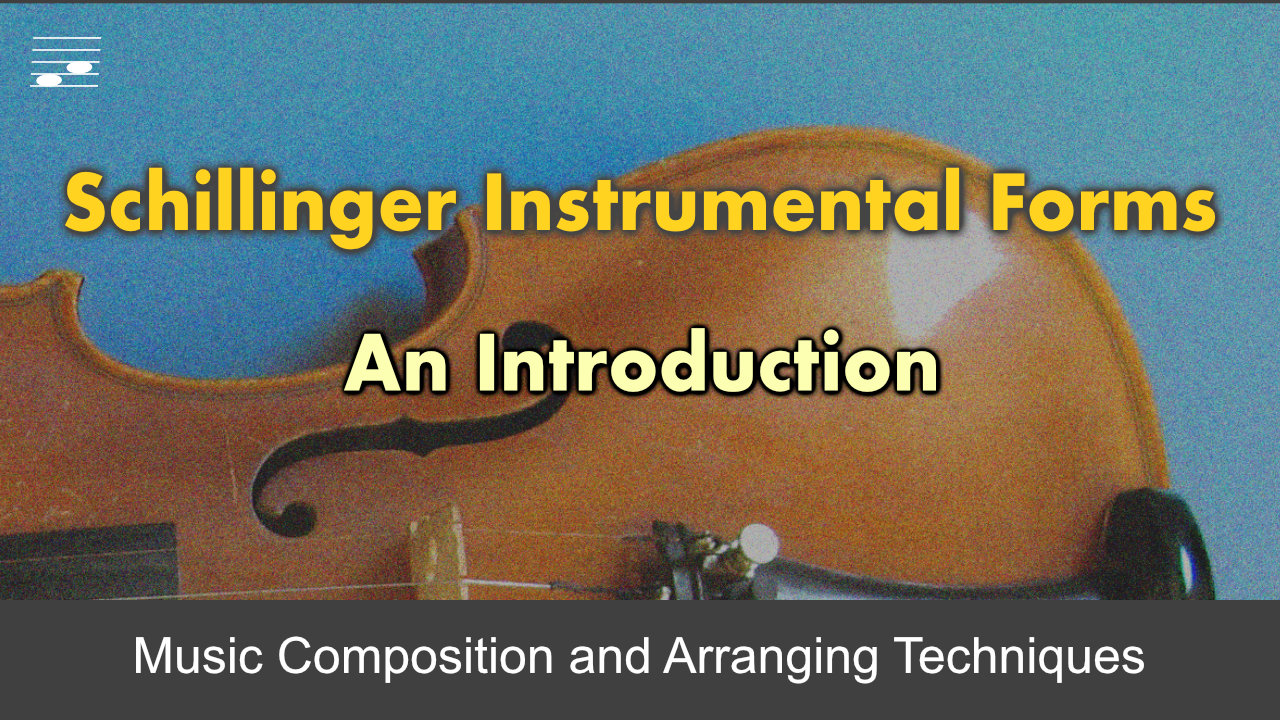 Schillinger Instrumental Forms: An Introduction (22:40) with an overview of Book 8 from the Schillinger System of Musical Composition. The creation of instrumental forms and arpeggio patterns is demonstrated for melody and harmony layers. There is a companion booklet with the overview diagram and score examples:
Schillinger Instrumental Forms: An Introduction.
Visit the Webshop >> (A4, PDF, 11 pp.).
Schillinger Instrumental Forms: An Introduction (22:40) with an overview of Book 8 from the Schillinger System of Musical Composition. The creation of instrumental forms and arpeggio patterns is demonstrated for melody and harmony layers. There is a companion booklet with the overview diagram and score examples:
Schillinger Instrumental Forms: An Introduction.
Visit the Webshop >> (A4, PDF, 11 pp.).
October 2021: Voice Leading in Schillinger Strata Harmony
Two new videos on the YouTube channel:
- The video tutorial
 Schillinger Strata Harmony: Voice Leading (25:30) has a focus on creating new, independent parts from the chordal functions in the existing chord structure layers. Doubling and coupling options are demonstrated in the diatonic and symmetric Schillinger Systems of Harmony. I've expanded the companion booklet with additional diagrams and score examples:
Schillinger Strata Harmony and Orchestration: An Example and Voice Leading.
Visit the Webshop >> (A4, PDF, 33 pp.).
Schillinger Strata Harmony: Voice Leading (25:30) has a focus on creating new, independent parts from the chordal functions in the existing chord structure layers. Doubling and coupling options are demonstrated in the diatonic and symmetric Schillinger Systems of Harmony. I've expanded the companion booklet with additional diagrams and score examples:
Schillinger Strata Harmony and Orchestration: An Example and Voice Leading.
Visit the Webshop >> (A4, PDF, 33 pp.).
- After reporting last month about the installation of the Metagrid app
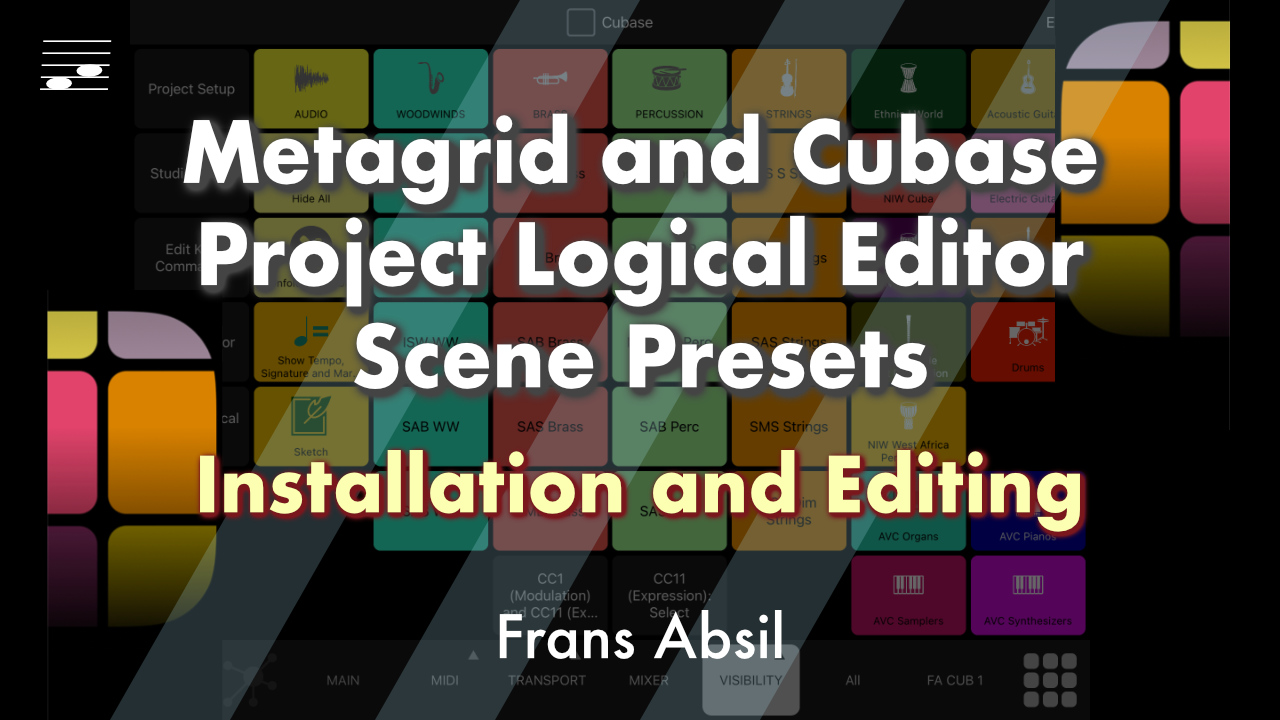 I created a video about
Metagrid and Cubase Project Logical Editor Scene Presets: Installation and Editing (6:06). I had some problems getting these to work, so decided to show how to enable these tools for track visibility control in Cubase.
I created a video about
Metagrid and Cubase Project Logical Editor Scene Presets: Installation and Editing (6:06). I had some problems getting these to work, so decided to show how to enable these tools for track visibility control in Cubase.
<< Previous - Top of page - Next >>
September 2021: SWAM Brass Sextet and using new apps
There's a virtual instrument review on the YouTube channel and first impressions of new apps:
- The video
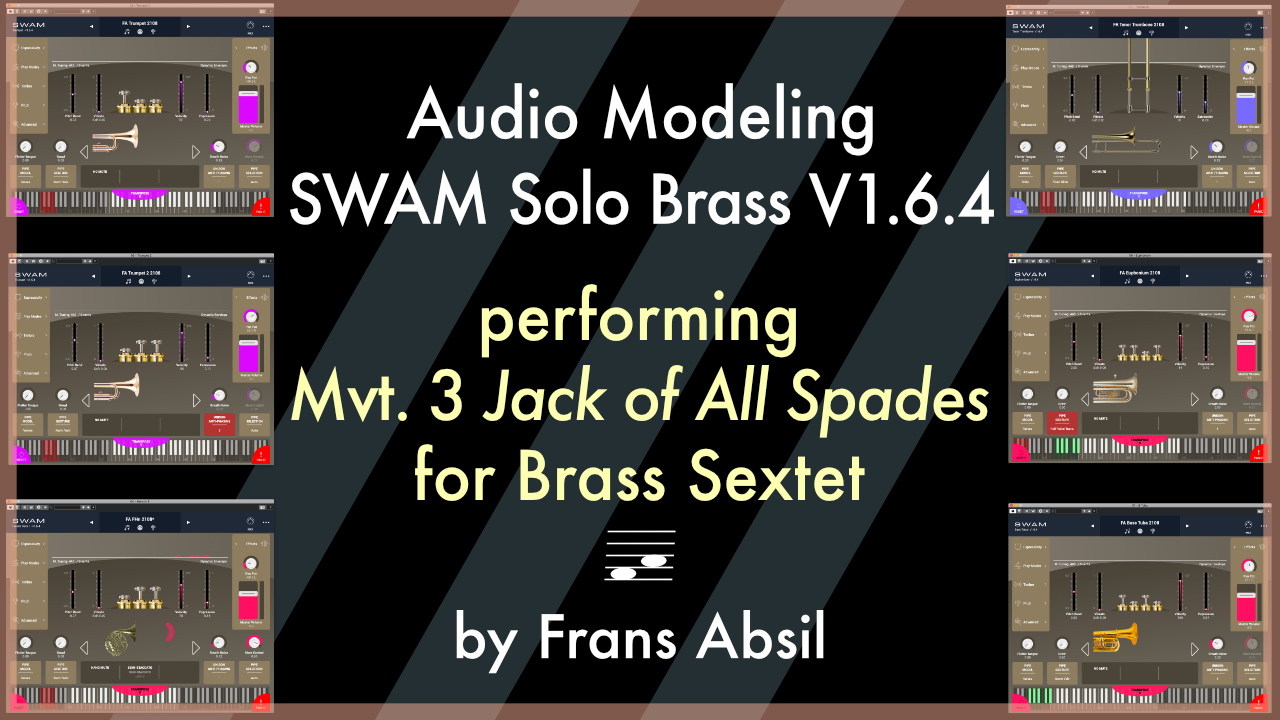 Audio Modeling SWAM Solo Brass V1.6.4 performing Mvt. 3 Jack of All Spades for Brass Sextet (3:41) is a testcase for the July 2021 update of these solo brass instruments, based on physical modeling. The jazz waltz from my brass sextet (trumpet 1 and 2, horn in F, trombone, euphonium and bass tuba) was recorded with an Akai EWI 5000, then edited in Cubase 11. This performance uses modified SWAM instrument presets and MIDI mappings. Read along with the annotated score and find my comments and experience report.
Audio Modeling SWAM Solo Brass V1.6.4 performing Mvt. 3 Jack of All Spades for Brass Sextet (3:41) is a testcase for the July 2021 update of these solo brass instruments, based on physical modeling. The jazz waltz from my brass sextet (trumpet 1 and 2, horn in F, trombone, euphonium and bass tuba) was recorded with an Akai EWI 5000, then edited in Cubase 11. This performance uses modified SWAM instrument presets and MIDI mappings. Read along with the annotated score and find my comments and experience report. - I've been a Mac user for years, but recently decided to use a Windows PC in parallel, with Cubase 11 (C11) and Vienna Ensemble Pro (VEP). Migrating from Mac to PC is a most laborious task. Since folder paths are different, this required careful software installation monitoring, editing all VEP instances and C11 track presets from the MAC. This is a procedure not to be recommended and should be done once in a lifetime only!
I'm in the middle of creating an orchestral template in Cubase, another tedious and demanding task. Since track numbers are running in the hundreds, the foreseeable next step is C11 project management and automation. To that end I started dipping my toes into the Hexler TouchOSC and the Metasystem Metagrid apps. Both iOS apps work for Mac and PC (one of my requirements) and undergo continuous development. The former will replace the Liine Lemur app, that seems to have come to total stasis. I'm happy to report that I managed to install the apps and servers, and did first succesful tests controlling the music software on both operating systems (not completely straightforward, and always scares me to death). Next on the agenda is the redesign of my tens of instrument MIDI controller layouts, learning the Lua scripting language (the umptieth) along the way. Another clever way of putting creative work on hold!
<< Previous - Top of page - Next >>
August 2021: Schillinger Strata Harmony technique and Website migration
New content on the YouTube channel and Website migration news:
- Learn about Schillinger Strata Harmony
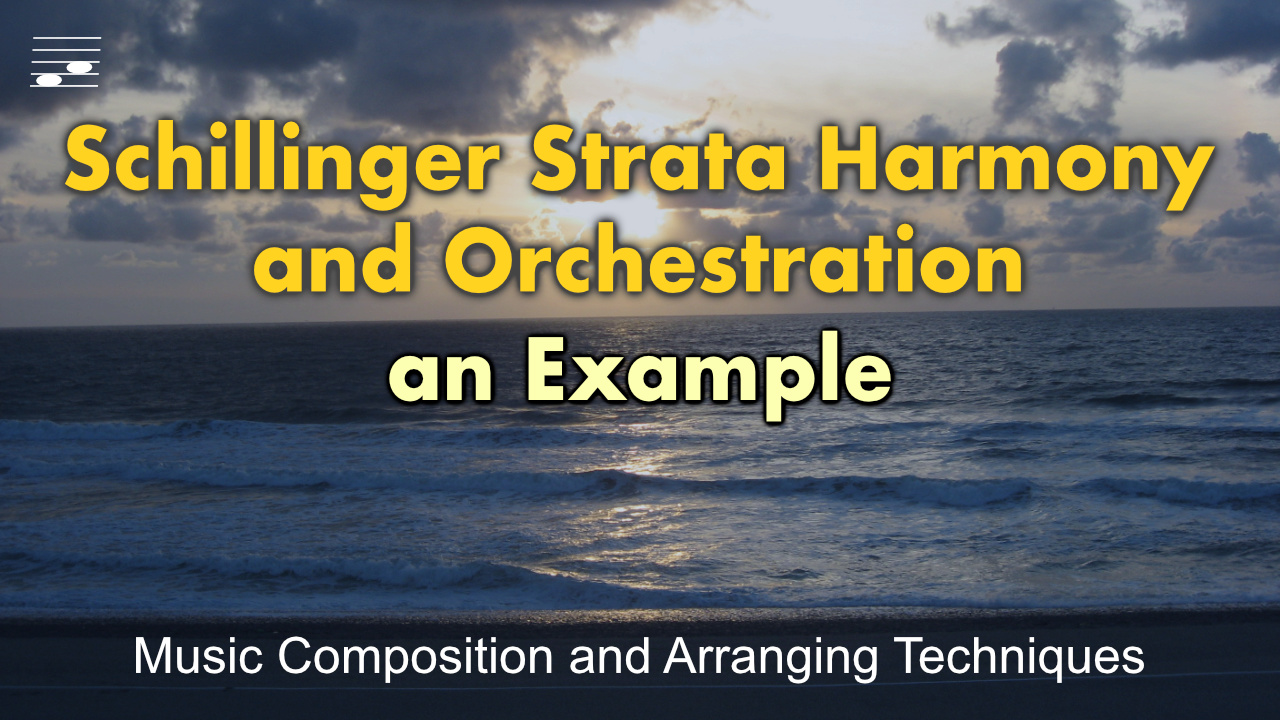 in the video tutorial
Schillinger Strata Harmony and Orchestration: An Example (32:44) This is a great technique for writing dense orchestral and electronic music settings and textures, e.g., for film or games. The ternary form example orchestral piece demonstrates continuities in the various harmony systems. The orchestration process and the design of instrumental forms is discused in detail. There is a full score
Exploring Stratospheres PDF Score (A3, 10 pp.)
and a companion booklet
Schillinger Strata Harmony and Orchestration: An Example.
Visit the Webshop >> (A4, PDF, 33 pp.).
in the video tutorial
Schillinger Strata Harmony and Orchestration: An Example (32:44) This is a great technique for writing dense orchestral and electronic music settings and textures, e.g., for film or games. The ternary form example orchestral piece demonstrates continuities in the various harmony systems. The orchestration process and the design of instrumental forms is discused in detail. There is a full score
Exploring Stratospheres PDF Score (A3, 10 pp.)
and a companion booklet
Schillinger Strata Harmony and Orchestration: An Example.
Visit the Webshop >> (A4, PDF, 33 pp.).
- Also on YouTube there's my entry to the
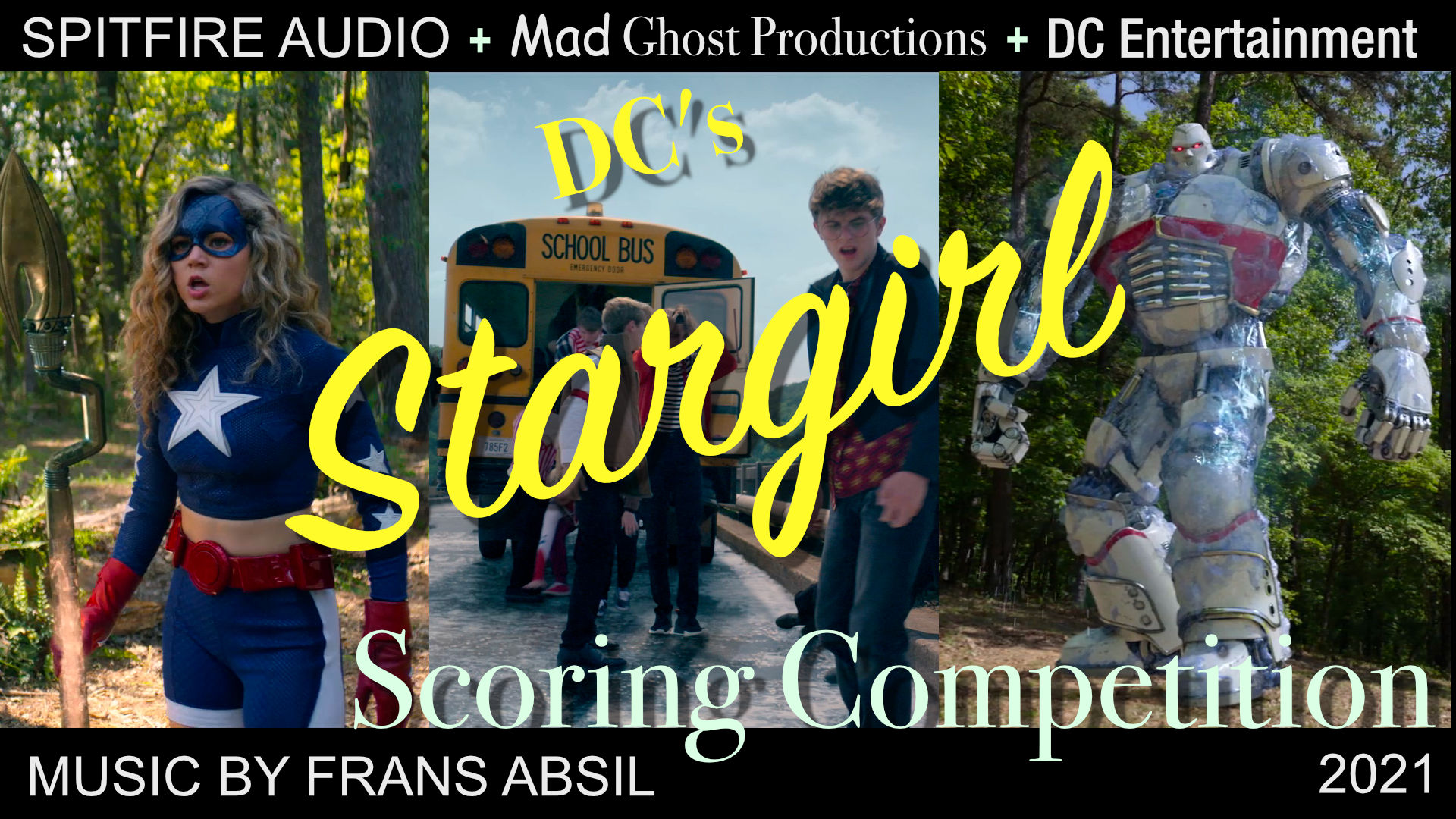 Spitfire Audio Stargirl Scoring Competition 2021 (2:01) with a score for the school bus scene from this DC Entertainment series. This track features 2 harps, 2 bass guitars, electric guitar, woodwinds, brass and synthesizers.
Spitfire Audio Stargirl Scoring Competition 2021 (2:01) with a score for the school bus scene from this DC Entertainment series. This track features 2 harps, 2 bass guitars, electric guitar, woodwinds, brass and synthesizers.
<< Previous - Top of page - Next >>
July 2021: Music analysis of Schumann's Vogel als Prophet for piano
Watch the new music analysis video on the YouTube channel:
- In his piano composition Vogel als Prophet, No.7 from Waldscenen Op. 82
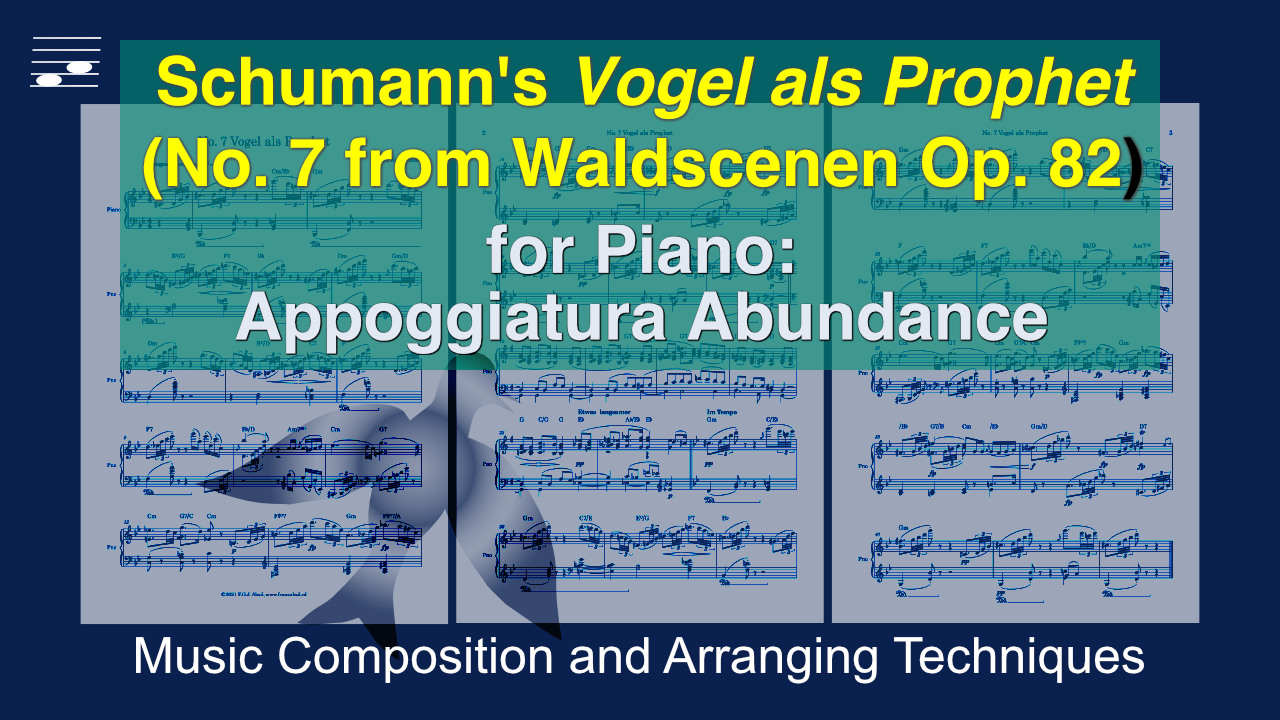 Robert Schumann made masterly use of arpeggio with appoggiatura patterns in the outer sections of this ternary piece. In the video
Schumann's Vogel als Prophet: Appoggiatura Abundance (18:17) I discuss these patterns in great detail, listing and classifying the various appoggiatura types, At the end there is a short composition with application of Riemannian Transformations and appoggiatura patterns. I created a companion booklet
Schumann's Vogel als Prophet: Appoggiatura Abundance.
Visit the Webshop >> (A4, PDF, 10 pp.).
Robert Schumann made masterly use of arpeggio with appoggiatura patterns in the outer sections of this ternary piece. In the video
Schumann's Vogel als Prophet: Appoggiatura Abundance (18:17) I discuss these patterns in great detail, listing and classifying the various appoggiatura types, At the end there is a short composition with application of Riemannian Transformations and appoggiatura patterns. I created a companion booklet
Schumann's Vogel als Prophet: Appoggiatura Abundance.
Visit the Webshop >> (A4, PDF, 10 pp.).
<< Previous - Top of page - Next >>
June 2021: Two composition technique tutorials, one instrument review
The recent uploads to the YouTube channel are:
- The composition techniques video tutorial
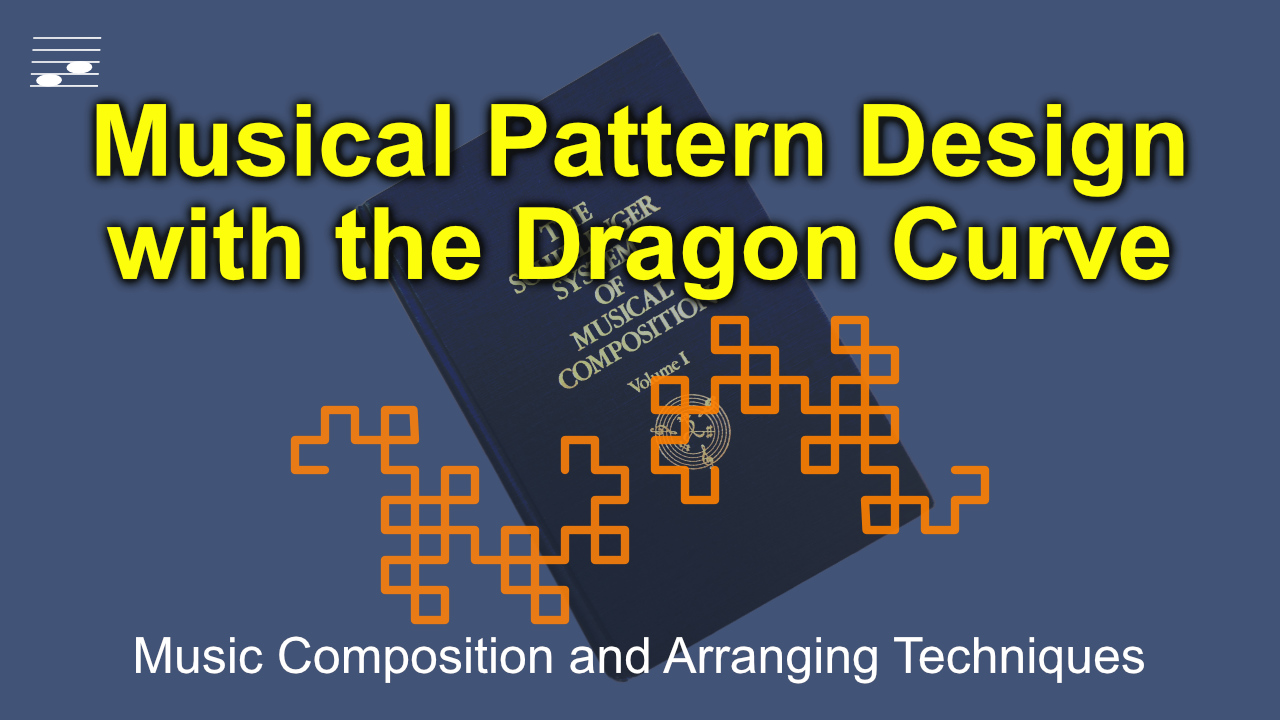 Musical Pattern Design With the Dragon Curve Fractal (20:17)
looks at its properties and application potential in the time, pitch and harmony domain. Percussion beating patterns and rhythms are derived from the turn sequence and may also be used in synthesizer sound design. The application in multiple domains in parallel is illustrated with an orchestral example, that combines two Schillinger harmony systems, a melody and countermelody. The examples demonstrate the development character equivalent of the fractal self-similar scaling property.
Musical Pattern Design With the Dragon Curve Fractal (20:17)
looks at its properties and application potential in the time, pitch and harmony domain. Percussion beating patterns and rhythms are derived from the turn sequence and may also be used in synthesizer sound design. The application in multiple domains in parallel is illustrated with an orchestral example, that combines two Schillinger harmony systems, a melody and countermelody. The examples demonstrate the development character equivalent of the fractal self-similar scaling property.
- The video
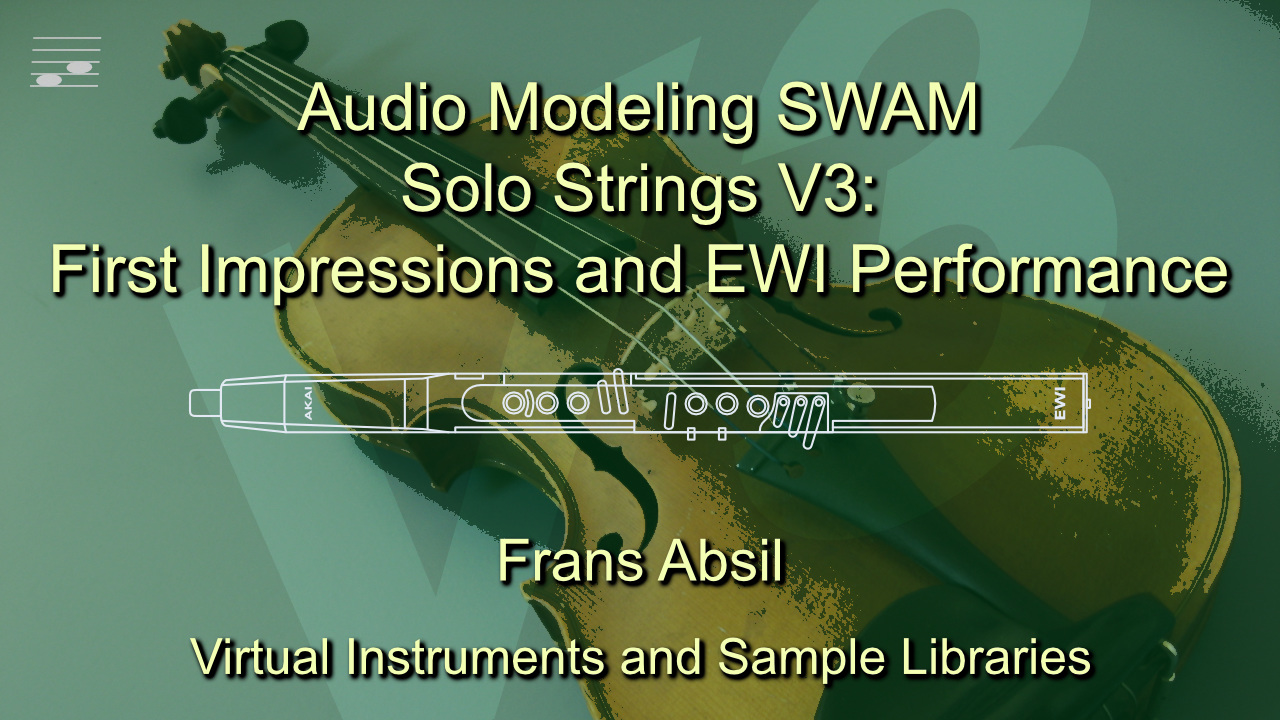 Audio Modeling SWAM Solo Strings V3: First Impressions and EWI Performance (15:02) presents first results for this physical modeling virtual instrument bundle, released in March 2021. Playing an AKAI EWI 5000 wind controller a number of etude and string quartet phrases demonstrate dynamics, articulation and expressivity.
Audio Modeling SWAM Solo Strings V3: First Impressions and EWI Performance (15:02) presents first results for this physical modeling virtual instrument bundle, released in March 2021. Playing an AKAI EWI 5000 wind controller a number of etude and string quartet phrases demonstrate dynamics, articulation and expressivity. - I completed the 2-part series on the Claude Debussy composition Nocturnes No. 2 Fêtes with its remarkable middle section, with continuous bass pedal point (pitch Ab), ternary form and two layers with harmony and modal scales. In the tutorial Nocturnal Party at Debussy's: Part 2 Metamorphosis, composing with the Fêtes middle section musical elements (28:47) these musical elements are used in a generalisation approach to create two new example compositions, an ambient texture and a funk idiom phrase.
- Find companion booklets Musical Pattern Design With the Dragon Curve Fractal. (A4, PDF, 8 pp.), and Nocturnal Party at Debussy's: Part 1 and 2 Fêtes middle section analysis and metamorphosis. Visit the Webshop >> (A4, PDF, 33 pp.).
<< Previous - Top of page - Next >>
April 2021: Analysing the Debussy Fêtes middle section
A fresh video on the YouTube channel looks at an orchestral piece from the impressionist period.
- The Claude Debussy composition Nocturnes No. 2 Fêtes has a fascinating middle section.
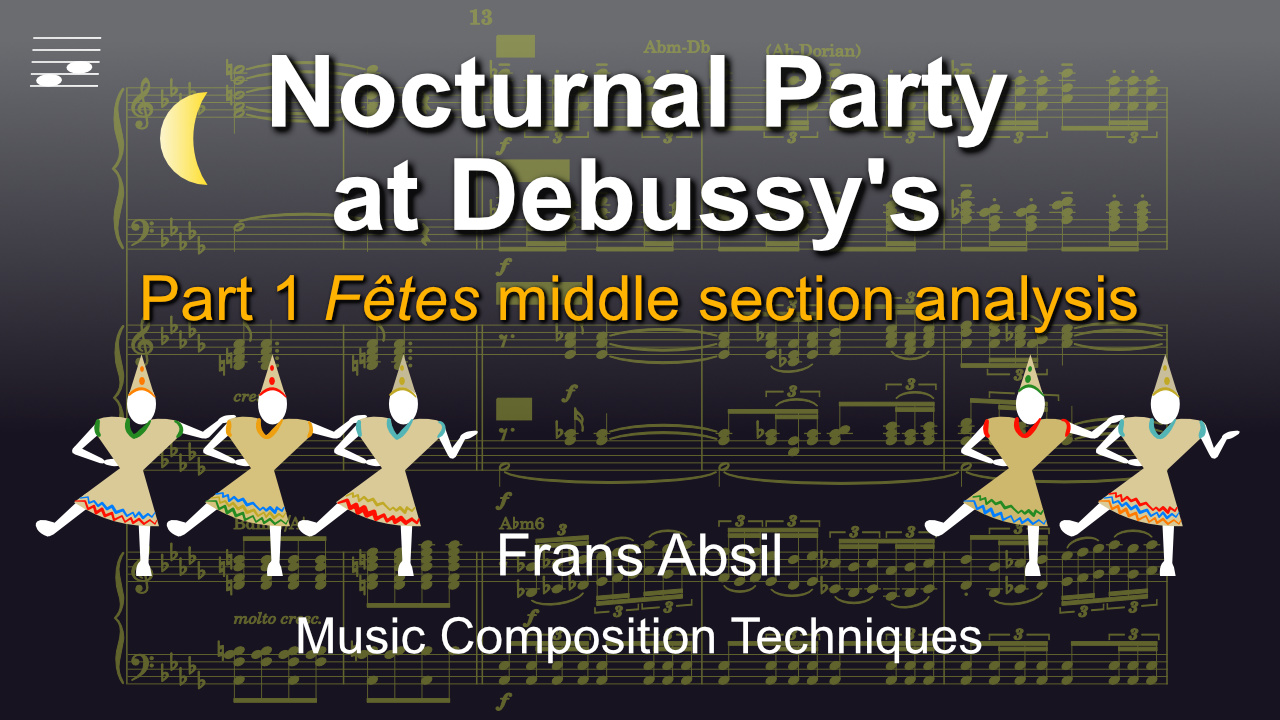 The tutorial
Nocturnal Party at Debussy's: Part 1 Fêtes middle section analysis (27:05) is about the ternary form, the two harmony layers above the bass pedal point, the use of modal scales and the detailed orchestration. These aspects are illustrated with Midi mockup audio fragments, and in Part 2 these techniques will be used to create new example compositions through generalisation.
The tutorial
Nocturnal Party at Debussy's: Part 1 Fêtes middle section analysis (27:05) is about the ternary form, the two harmony layers above the bass pedal point, the use of modal scales and the detailed orchestration. These aspects are illustrated with Midi mockup audio fragments, and in Part 2 these techniques will be used to create new example compositions through generalisation.
<< Previous - Top of page - Next >>
March 2021: Tutorial on Schillinger's Second Group of Pitch-Scales
Here's the new content on the YouTube channel and in the Document Library.
- The video tutorial
 Schillinger's Theory of Pitch-Scales: Second Group Properties and Application Examples (29:52) is the 4th episode in the series on scales. It covers the Method of Tonal Expansion for generating scales with a range exceeding the octave, the use of Melodic Forms and Modal Derivative Scales, and the creation of a Melodic Continuity. These techniques are applied in three short composition examples, an orchestral piece, a synthesizer texture and a bossa nova phrase.
Schillinger's Theory of Pitch-Scales: Second Group Properties and Application Examples (29:52) is the 4th episode in the series on scales. It covers the Method of Tonal Expansion for generating scales with a range exceeding the octave, the use of Melodic Forms and Modal Derivative Scales, and the creation of a Melodic Continuity. These techniques are applied in three short composition examples, an orchestral piece, a synthesizer texture and a bossa nova phrase.
- As promised last month, you may now find a memorandum (PDF, A4, 3 pp.) that describes the setup and configuration of the Arturia KeyLab mkii 61 as a DAW controller in Cubase in detail. Here's the link: Using the Arturia KeyLab Mk2 61 in Cubase: The Bermuda Triangle of Software Configuration. It has been added to the Document Library.
<< Previous - Top of page - Next >>
February 2021: The use of harmony in the Rosenkavalier Waltz
The main contribution this month is an upload to the YouTube channel.
- The waltz section from the Richard Strauss opera 'Der Rosenkavalier' has form ABABC, with remarkable harmony in the B-sections.
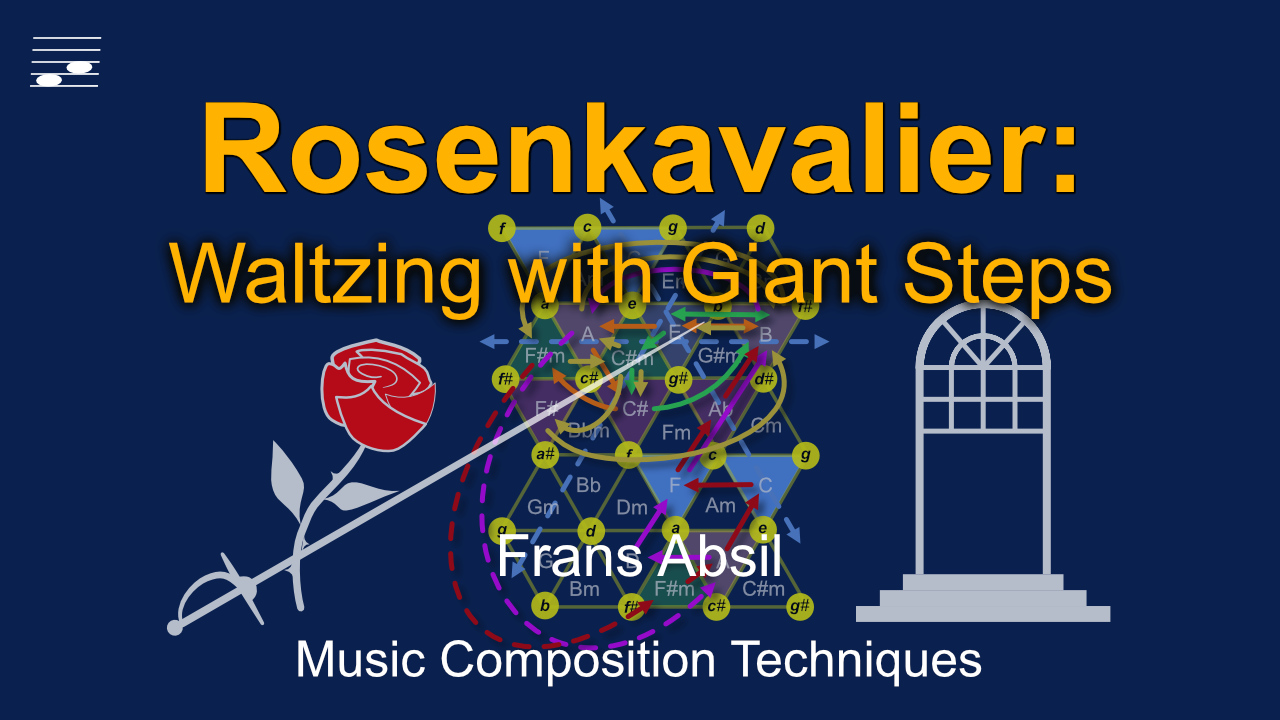 In the video tutorial
Rosenkavalier: Waltzing with Giant Steps (23:58)
you'll find an analysis of this waltz. The A-sections use diatonic harmony, while the B-phrases are based on symmetric harmony systems (see the Schillinger System of Musical Composition), not unlike the chord changes in the John Coltrane composition 'GIant Steps'. Chord progressions are depicted as trajectories in the triad Tonnetz diagram. A similar harmony approach has been used in the short example composition, 'Waltzing with R'. For more details on this composition and a video tutorial companion booklet (PDF, A4, 23 pp.) visit the
'Waltzing with R' documentation page >>
In the video tutorial
Rosenkavalier: Waltzing with Giant Steps (23:58)
you'll find an analysis of this waltz. The A-sections use diatonic harmony, while the B-phrases are based on symmetric harmony systems (see the Schillinger System of Musical Composition), not unlike the chord changes in the John Coltrane composition 'GIant Steps'. Chord progressions are depicted as trajectories in the triad Tonnetz diagram. A similar harmony approach has been used in the short example composition, 'Waltzing with R'. For more details on this composition and a video tutorial companion booklet (PDF, A4, 23 pp.) visit the
'Waltzing with R' documentation page >>
- At the start of 2021 I was struck with fresh Cubase disaster. It started with Drum Maps being invisible, then later the Arturia KeyLab Mk2 DAW controller became inactive and finally the DAW software itself behaved erratic. It took many hours to identify the culprit, and a probably unnecessary full Cubase re-install (plus the then inevitable restoring of preferences, presets, settings, etc.). Turns out that the MacOS Audio-Midi setup also played a part in this trio, probably after an Arturia firmware update. I will soon report my experience in a short document, that may help others with the same phenomenon (searching the Internet I noticed similar partial problems, but this combination and solution I did not find). Update March 2021: Here's the link to the PDF memorandum: Using the Arturia KeyLab Mk2 61 in Cubase: The Bermuda Triangle of Software Configuration.
<< Previous - Top of page - Next >>
January 2021: The Spitfire Audio Westworld Scoring competition entry revisited
The past year (2020) was concluded with a making of video on the YouTube channel.
-
The episode
Composing with Twelvetone Triads: The HBO Westworld Car Chase Scene (33:23)
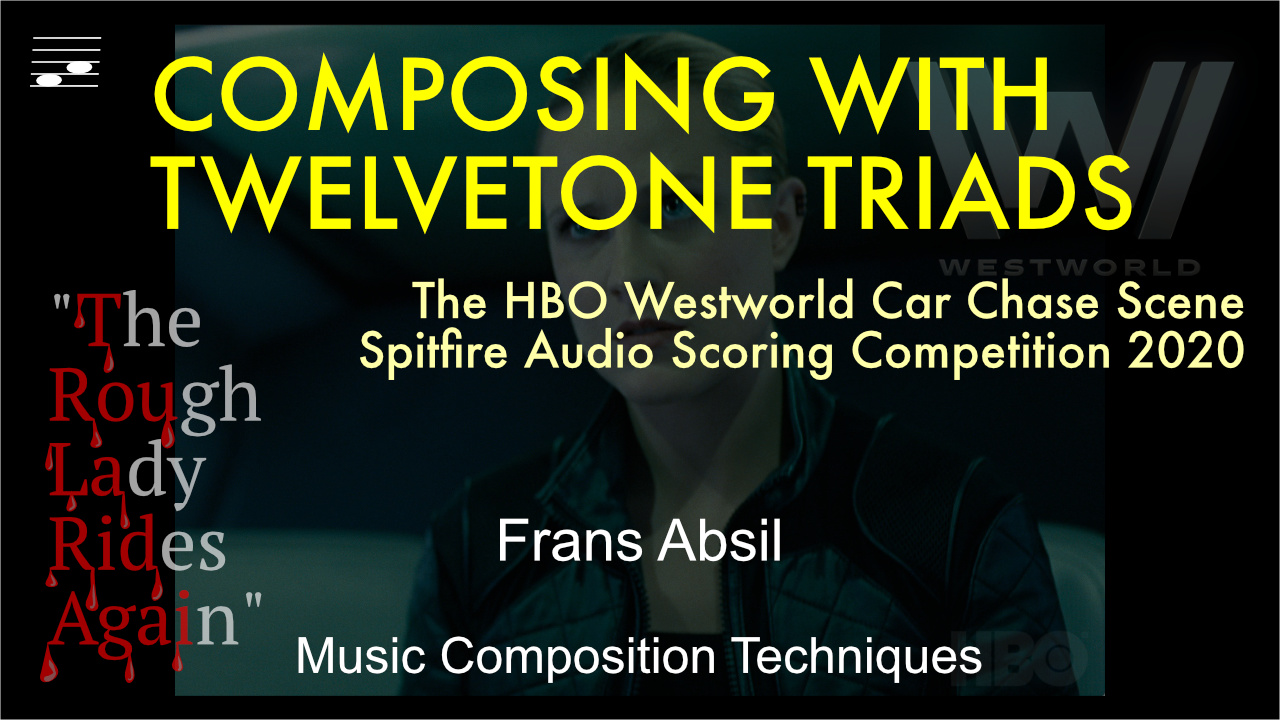 revisits my Spitfire Audio Scoring Competition 2020 entry. It discusses the film music composition process with a single set of 12-tone triads (CM, Ebm, Db+ and G#o) in detail. Learn how hexachords from pairwise triad combinations were used to create harmony, melody and counterpoint, and how a consistent atonal idiom with chord tension control was achieved. This tutorial contains reduced score, audio and movie excerpts. For a companion booklet (PDF, A4, 25 pp.) visit the
'The Rough Lady Rides Again' documentation page >>
revisits my Spitfire Audio Scoring Competition 2020 entry. It discusses the film music composition process with a single set of 12-tone triads (CM, Ebm, Db+ and G#o) in detail. Learn how hexachords from pairwise triad combinations were used to create harmony, melody and counterpoint, and how a consistent atonal idiom with chord tension control was achieved. This tutorial contains reduced score, audio and movie excerpts. For a companion booklet (PDF, A4, 25 pp.) visit the
'The Rough Lady Rides Again' documentation page >>
- I have been mentioning problems with the Arturia controller software, virtual instruments and the Midi mapping (see Mar 2020, Sep 2019 and May 2019). I am happy to report that with the recent KeyLab Mk2 firmware V1.2.4, the Midi Control Center V1.12.1 (Oct 2020) and the V Collection 7 update with improved GUI and Midi editing capabilities (Dec 2020) many shortcomings have been removed. Read more on the updated Arturia V Collection Default Midi Controller Configuration page.
